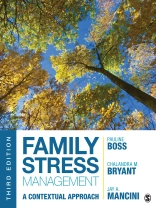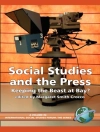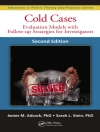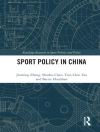Why do some families survive stressful situations while others fall apart? Can a family’s beliefs and values be used as a predictor of vulnerability to stress? And most importantly, can family stress be prevented?
The
Third Edition of
Family Stress Management continues its original commitment to recognize both the external and internal contexts in which distressed families find themselves. With its hallmark Contextual Model of Family Stress (CMFS), the
Third Edition provides practitioners and researchers with a useful framework to understand and help distressed individuals, couples, and families. The example of a universal stressor—a death in the family—highlights cultural differences in ways of coping. Throughout, there is new emphasis on diversity and the nuances of family stress management—such as ambiguous loss—plus new discussions on family resilience and community as resources for support.
Mục lục
Preface
Acknowledgments
About the Authors
Chapter 1- Family Stress: An Overview
Defining Family Stress
Defining Family
An Example of Diversity in Family Structure: Grandparents Parenting Grandchildren
What Were Our Own Families Like?
General Systems Theory: The Family as System
Symbolic Interaction as a Basis for Studying Perceptions and Meanings
Is There a Family Perception?
Problematic Perceptions
Diversity and Multiculturalism in Family Stress Management
Minority Stress
Acculturative and Bicultural Stress
The Stress of Discrimination and Racism
Gender and Family Stress
Trends in the 1970s
Trends in the 1980s
Trends in the 1990s
Current Trends
Summary
Points to Remember
Discussion Questions
Note
Additional Readings
Chapter 2- The Contextual Model of Family Stress
Why a Contextual Model?
The Family’s External Context
Cultural Context
Historical Context
Economic Context
Developmental Context
Hereditary Context
Summary
The Family’s Internal Context (Structural, Psychological, and Philosophical)
The ABC-X of Family Stress: A Frame for Definitions
The A Factor: Stressor Event (Stressful Event)
The Danger of Circular Reasoning
Classification of Family Stressor Events
Cautions About Defining a Stressor Event
The B Factor: Resources (Individual, Family, and Community)
The C Factor: Perception
The Primacy of Perceptions
Collective Versus Individual Perceptions
The X Factor: Family Crisis
The Roller Coaster Model of Family Crisis
Linking the ABC-X Model to the Roller Coaster Model of Family Crisis
The Turning Point: Family Recovery After Crisis
Family Strain
Summary
Points to Remember
Note
Discussion Questions
Additional Readings
Chapter 3- Multicultural Perspectives of a Universal Stressor
The Stress of Grief and Loss from Death
Cultural Perceptions of Death and Loss
Definitions of Death
Resolving Loss
Same Religion, Different Culture
African American
Asian
Peruvian
Irish
Jewish
Identity and Status in One’s Family After a Death
Applying the Contextual Model of Family Stress to This Universal Stressor
Where Is the Field Now?
Conclusion
Summary
Points to Remember
Discussion Questions
Additional Readings
Chapter 4- Ambiguous Loss: A Major Stressor
Ambiguous Loss Theory
Premise
Types of Ambiguous Loss
Effects of Ambiguous Loss
Individual Level
Family Level
Community Level
Core Assumptions for Working With Ambiguous Loss
Interventions: What Helps With Ambiguous Loss?
What Ambiguous Loss Is Not
Ambiguity Is Not Ambivalence
Ambiguity Is Not Uncertainty
Ambiguous Loss and Spirituality
Ambiguous Gain Versus Ambiguous Loss
Conclusion
Summary
Points to Remember
Notes
Discussion Questions
Additional Readings
Chapter 5- Boundary Ambiguity: A Perceptual Risk Factor in Family Stress Management
Measurement of Boundary Ambiguity
History of Boundary Ambiguity
Sociological and Psychological Roots
Family Therapy Roots
Entries and Exits; Gains and Losses
Normative Developmental Boundary Ambiguity Across the Family Life Cycle
Exceptions and Nuances
Effects of Boundary Ambiguity
Assumptions About Boundary Ambiguity
What Boundary Ambiguity Is Not
Boundary Ambiguity Is Not Boundary Maintenance
Boundary Ambiguity Is Not Boundary Permeability
Intervention for Boundary Ambiguity
New Studies and Future Directions
Summary
Points to Remember
Discussion Questions
Additional Readings
Chapter 6- Family Coping, Adapting, and Managing
Defining Individual and Family Coping
Individual Coping
Family Coping
Current Trends in Coping Research
Denial Coping
Approach/Avoidance Coping
Forbearance Coping
Preparedness Coping
Humor Coping
Religious Coping
Repressive Coping
Coping Ugly
Coping and the Contextual Model of Family Stress
Family Coping Resources
Individual Coping Resources
Community Resources for Family Coping
Intervention and Prevention
Psychoeducation as Effective Family Stress Intervention
How Did This Simple but Revolutionary Idea in Mental Health Treatment Come About?
The First Step: Where to Begin?
Complexities of the Coping Process
The Paradox of Individual Versus Family Coping
The Paradox of Functional Versus Dysfunctional Coping
Dialectical Thinking: Definition and Early Roots
The Chain Reaction of Coping or the Codetermination of Events
Cautions About Coping
Concluding Thoughts for Future Work
Summary
Points to Remember
Discussion Questions
Additional Readings
Chapter 7- Resilience for Managing Stress
The Difference Between Coping and Resilience
Defining Resilience
Resilience and Family Stress
Individual, Family, and Community Resilience
Ordinary Magic
Resilience and the Contextual Model of Family Stress
The Family’s External Context
The Family’s Internal Context
Revisiting the ABC-X Approach
Adversity and Resilience
Positive, Tolerable, and Toxic Stress
Intensity of Adversity
The Era of Resilience
Resilience Theorizing and Research Over the Years
Individual Resilience
Family Resilience
Family Science Conceptual Frameworks Focused on Resilience
Life Course Theory
Symbolic Interaction Theory
Family Stress Theory
An Example: Application to Military Families
A Third-Wave Family Resilience Framework
Resilience Frameworks Focused on Particular Situations
Resilience-Informed Professional Practice
Prevention and Resilience
Use of Family Resilience Frameworks
Cautions About Resilience
Troublesome Theorizing
The Cost of Resilience
Rebellion and Opposing the Status Quo
Conclusion
Summary
Points to Remember
Discussion Questions
Additional Readings
Chapter 8- Families, Communities, and Neighborhoods
Defining Community and Neighborhood
Sense of Community
Virtual Sense of Community
Community and Neighborhood
Communities and the Contextual Model of Family Stress
Research Findings on Families and Communities
Informal Connections and Relationships
Formal System Programs for Families
Neighborhood Risk
Exposure to Violence
Other Dimensions of Communities
The Social Organization Framework
Informal Networks
The Physical Environment
Community Capacity
Results for Families
The Value of Social Connections for Families
Resilient Communities
Four Types of Communities
Fluid and Dynamic Communities
Social Cohesion
Communities as Place and Force for Prevention and Intervention With Distressed Families
Communities as Place
Communities as Force
Community Family Therapy
Conclusion
Summary
Points to Remember
Note
Discussion Questions
Additional Readings
Chapter 9- Future Challenges to Family Stress Management
Health Disparities
Climate Change
Widening Economic Gulf Between Low and High Income Families
Increasing Work Pressures and Economic Conditions
Terrorism
Conflict Driven by Religious Differences
Family Caregiving Challenges and Dilemmas
Transgender Trends and Challenges
Increasing Focus on Community
Violence in Communities
Families on New Shores
Additional Factors to Consider About the Study of Family Stress
Conclusion
Summary
Points to Remember
Discussion Questions
Additional Readings
References
Index
Giới thiệu về tác giả
Jay A. Mancini is the Haltiwanger Distinguished Professor of Human Development and Family Science at the University of Georgia and Emeritus Professor of Human Development at Virginia Tech. Mancini was the 2013 Ambiguous Loss Visiting Scholar at the University of Minnesota. He received his doctoral degree in child development and family relations from the University of North Carolina at Greensboro. Mancini is a Fellow of the National Council on Family Relations (NCFR). His theorizing and research focuses on the intersections of vulnerability and resilience, and over his career, his research projects have focused on families and time-use, family gerontology, psychological well-being in adulthood, sustainability of community-based programs for at-risk families, community context effects on families, and quality of life among military families.












